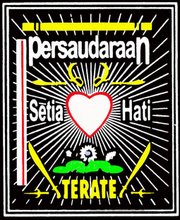The weapons employed in Pentjak Silat are a combination of indigenous weapons and those brought to Indonesia from the entire Asian continent. A number of these weapons were originally tools used to worked the land. Virtually every traditional Pentjak Silat style employs the following weapons.
The weapons employed in Pentjak Silat are a combination of indigenous weapons and those brought to Indonesia from the entire Asian continent. A number of these weapons were originally tools used to worked the land. Virtually every traditional Pentjak Silat style employs the following weapons.
Pisau or belati
The pisau is a short knife with no specific form or length.
Golok and parang
The golok is a short, heavy machete with a single-sided blade. The parang is also a type of machete that is used extensively. Both were originally used as farming tools.
Trisula
The trisula is a three-pronged metal fork. It varies in length from 25 to 65 cm. The trisula is most likely of Indian origin.
Toya
The toya is a wooden staff, generally made of rattan. It varies in length from 1.5 to 2 meters, but in principle is slightly shorter than the person using it. The toya is between 3.5 and 5.0 cm in diameter.
In addition to the weapons mentioned above, most Pentjak Silat styles also employ their own specific weapons. In the PSHT, the following weapons are also used.
Celurit
Celurit is the Indonesian term for a sickle, a farming implement with a short, steel blade in the shape of a half-moon. The “ant” is a smaller sickle. The cutting edge is on the inside of the blade.
Krambit
The krambit is a fist-held punching brace with a double-sided blade in the shape of a half-moon. The krambit is originally a Moslem weapon. The PSHT is the only Pentjak Silat style to employ this weapon.
Monday, April 30, 2007
Weapons
Diposkan oleh
Imam Malik
di
7:24 PM
![]()
Subscribe to:
Post Comments (Atom)


No comments:
Post a Comment